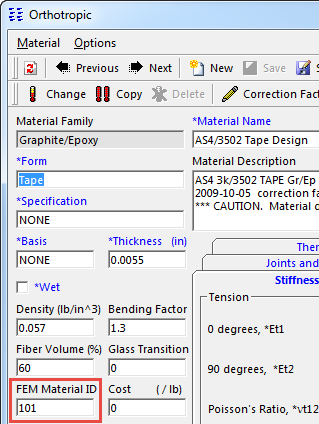
Existing designs in finite element models where layups and materials are defined with PCOMP and MAT cards (or with layered section data in Abaqus and ANSYS) can be imported and analyzed with relatively minimal additional setup. Examples include:
Important: Material stiffness and allowable properties are never imported from the FEM. This is because detailed stress analysis requires a much richer set of material properties than that required by FEA.
The key to this capability is to map the HyperSizer materials to MAT cards in the FEM. Consider the following PCOMP and corresponding MAT8 entries.
MAT8 101 1.9E+7 1380000. 0.3 543000. 543000. 543000. 1.48E-4
-1.E-7 1.5E-5 72. 205000. 171000. 13500. 32300. 13400.
MAT8 504 1.E-4 1.E-4 0.33333 1.E-4 31000. 98000.1.198E-5
0. 0. 72.
PCOMP 101 -1.6908 2.88E-6 347. 72. +
+ 101 0.0053 45. YES 101 0.0053 -45. YES+
+ 101 0.0053 0. YES 101 0.0053 90. YES+
+ 504 3. 0. YES 101 0.0053 90. YES+
+ 101 0.0053 0. YES 101 0.0053 -45. YES+
+ 101 0.0053 45. YES
In order for HyperSizer to import and set up this PCOMP correctly, you must link HyperSizer materials to Nastran MAT8 cards 101 and 504. This is done by declaring the FEM material ID in the material form. Be aware that material properties are not imported from the finite element model.
For the above example, the composite ply material is represented by MAT8 ID 101. In HyperSizer, the FEM material is linked to the HyperSizer material by specifying a FEM material ID of 101 in the Orthotropic material form.

